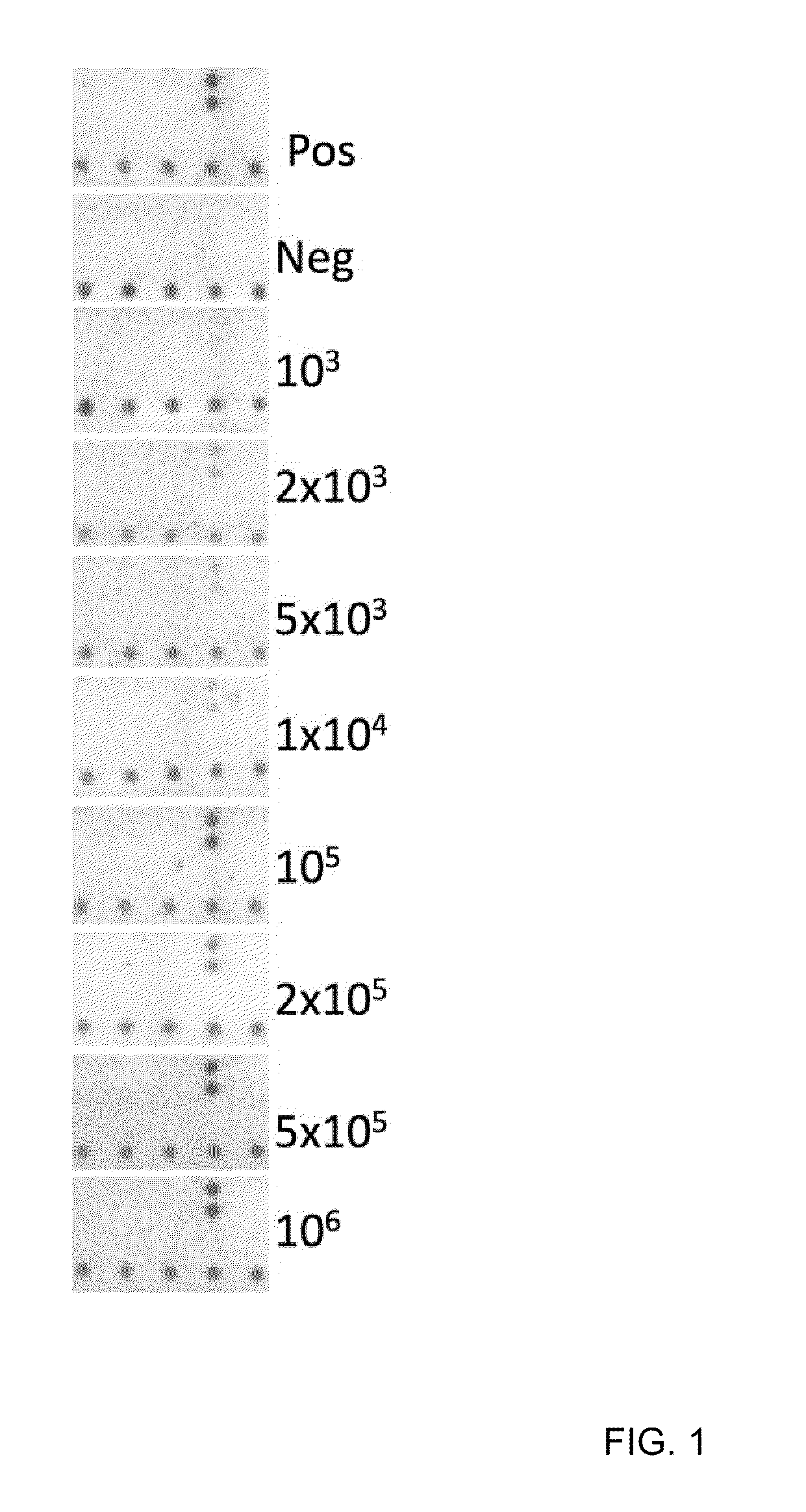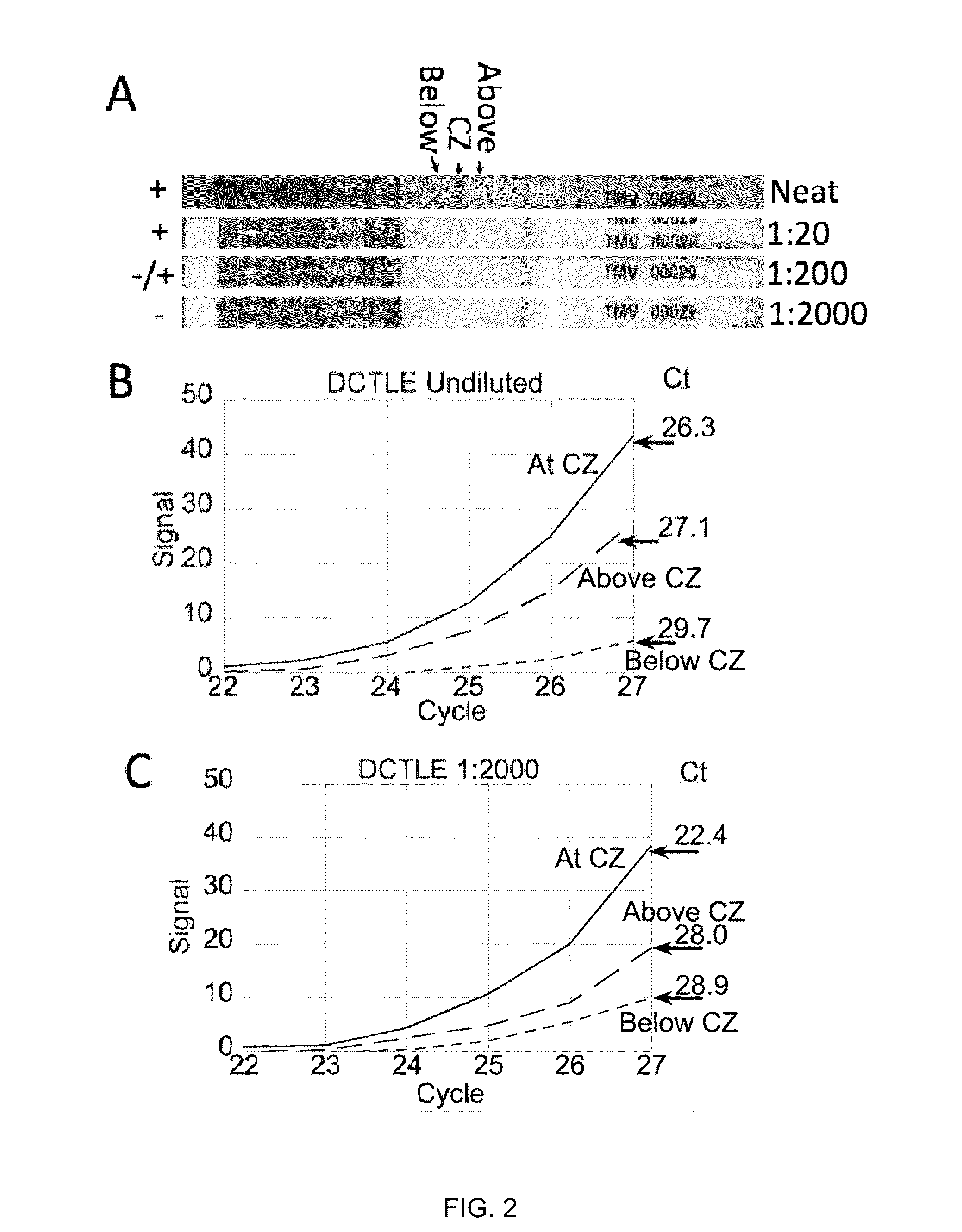Highly Simplified Lateral Flow-Based Nucleic Acid Sample Preparation and Passive Fluid Flow Control
- Summary
- Abstract
- Description
- Claims
- Application Information
AI Technical Summary
Benefits of technology
Problems solved by technology
Method used
Image
Examples
example 1
NASBA Amplification of RNA from Crude Bacterial Cell Lysates
[0056]In order to evaluate the feasibility of using crude lysates to supply template RNA for amplification, the efficacy of NASBA amplification from E. coli lysates was examined. Lysates were prepared by adding varying quantities of E. coli liquid culture to cells-to-cDNA buffer (Ambion) and heating to 75° C. for 10 minutes. This method was reported to generate suitable template for RT-PCR (reverse transcriptase-polymerase chain reaction) from crude L. moncytogenes lysates [49]. Lysates were diluted 1:5 and 2 μL of the resulting material used in a 10 μL NASBA reaction. A constitutively expressed mRNA, rpIV, was used as the NASBA target [50]. NASBA P1 and P2 primer sequences were as follows:
EC-rplV-P1:[SEQ ID NO: 1]5′-aattctaatacgactcactatagggagaaggCCATCGTTGTGTTCAGCGTTA-3′andEC-rplV-P2:[SEQ ID NO: 2]5′-gatgca aggtcg cat atg agAACTATCGCTAAACATCGCCA-3′.
Lower case characters in the P1 sequence denote the T7 RNA polymerase promo...
example 2
Lateral Flow Concentration of Analyte and Subsequent Amplification from TMV Particles Contained within Leaf Tissue
[0058]In this Example, the utility of lateral flow facilitated immune-capture as a means of concentrating analyte prior to nucleic acid isolation or amplification was investigated with tobacco mosaic virus (TMV).
[0059]FIG. 2A-C depicts the results of immuno-affinity capture and concentration of tobacco mosaic virus (TMV) particles during lateral flow of 200 μL of crude macerated tobacco and subsequent amplification (reverse-transcriptase-PCR) reactions programmed with regions of the lateral flow substrate below (proximal to the sample pad), at and above (distal to the sample pad) the immune-capture zone (as shown in FIG. 2A). The capture zone is greatly enriched in virus particles while the relative concentration of inhibitory constituents is reduced. The 1000-fold reduction of sample volume from 200 μL to 200 nL, based on the calculated bed volume of the capture zone, e...
example 3
Lateral Flow Reduction of Amplification Inhibitors Using Polyvinylpyrrolidone
[0061]This Example shows that polyvinylpyrrolidone treated sample pads can deplete PCR inhibitors via lateral flow.
[0062]Crude sample constituents inhibitory to PCR can be depleted during lateral flow; thus specific substrate treatments may further facilitate amplification of nucleic acids from captured target cells or particles. To test this hypothesis, absorbent sample pads were treated with a 10% solution of polyvinylpyrrolidone (MW=360,000) and RT-PCR amplification of TMV concentrated from macerated leaf tissue following lateral flow immuno-capture (Example 2, supra) on devices carrying either PVP treated or untreated sample pads was evaluated.
[0063]These reactions made use of previously reported primer sets for TMV detection. Neat tobacco extract added directly to RT-PCR reactions was negative for TMV without prior immuno-capture to deplete inhibitors. Consistent with this interpretation, 1:50 dilution...
PUM
| Property | Measurement | Unit |
|---|---|---|
| Current | aaaaa | aaaaa |
| Current | aaaaa | aaaaa |
| Current | aaaaa | aaaaa |
Abstract
Description
Claims
Application Information
 Login to View More
Login to View More - R&D
- Intellectual Property
- Life Sciences
- Materials
- Tech Scout
- Unparalleled Data Quality
- Higher Quality Content
- 60% Fewer Hallucinations
Browse by: Latest US Patents, China's latest patents, Technical Efficacy Thesaurus, Application Domain, Technology Topic, Popular Technical Reports.
© 2025 PatSnap. All rights reserved.Legal|Privacy policy|Modern Slavery Act Transparency Statement|Sitemap|About US| Contact US: help@patsnap.com



